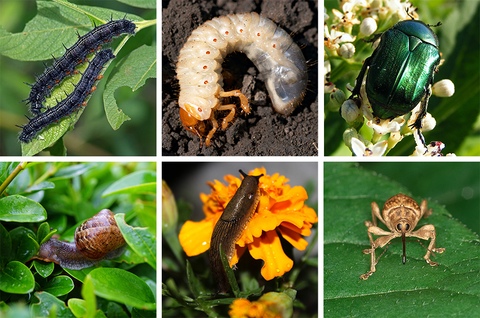Maintaining a thriving garden involves more than just sowing seeds and providing water and sunlight. It's a delicate balance of nature, where beneficial insects play a crucial role in keeping harmful pests at bay. In this guide, we'll explore the world of beneficial insects, understand their roles, and learn how to encourage them for a naturally pest-resistant garden. The following content also has some reference value for raised garden beds.
The Unsung Heroes: Beneficial Insects in Your Garden
Gardens are ecosystems teeming with life, and many insects are natural allies in the battle against common pests. By attracting and supporting beneficial insects, you create a self-sustaining environment that minimizes the need for chemical interventions. Let's meet some of these garden superheroes:

1. Ladybugs (Ladybirds): Nature's Aphid Assassins
- Role: Ladybugs are voracious predators of aphids, mites, and scale insects.
- Encouraging Presence: Plant pollen-rich flowers like daisies and marigolds to attract and provide sustenance for adult ladybugs. Avoid using broad-spectrum pesticides that can harm them.
2. Praying Mantises: Silent Garden Guardians
- Role: Praying mantises are generalist predators, feeding on a variety of insects, including caterpillars and beetles.
- Encouraging Presence: Provide tall grasses and shrubs for mantises to lay their egg cases. Avoid excessive use of insecticides, as mantises are susceptible to them.
3. Parasitic Wasps: Tiny Protectors
- Role: Parasitic wasps lay their eggs on or inside other insects, controlling populations of caterpillars, aphids, and other pests.
- Encouraging Presence: Plant nectar-rich flowers such as dill, fennel, and yarrow to attract adult parasitic wasps. Maintain diverse plantings to offer a variety of habitats.
4. Ground Beetles: Guardians of the Soil
- Role: Ground beetles feed on soil-dwelling pests like slugs, snails, and root maggots.
- Encouraging Presence: Provide ground cover and organic mulch for ground beetles to hide during the day. Minimize the use of chemical pesticides that can harm these beneficial insects.
5. Hoverflies: Nature's Tiny Pollinators and Predators
- Role: Hoverfly larvae devour aphids, while adult hoverflies contribute to pollination.
- Encouraging Presence: Plant flowers like alyssum and daisies to attract adult hoverflies. Avoid using systemic insecticides that can harm both larvae and adults.
6. Green Lacewings: Aphid-Eating Allies
- Role: Green lacewing larvae are voracious aphid predators.
- Encouraging Presence: Provide nectar-producing plants like dill and angelica to attract adult lacewings. Avoid using broad-spectrum pesticides harmful to lacewing larvae.
Creating a Haven for Beneficial Insects
Now that we've met our garden superheroes, let's explore how to create an environment that encourages their presence:
Diverse Plantings
- Why: A variety of plant species attracts a diverse range of insects. Different plants provide different habitats and food sources.
- How: Plant flowers with varying shapes, sizes, and bloom times. Include herbs like parsley and cilantro alongside ornamental plants.
Avoid Excessive Pesticide Use
- Why: Pesticides can harm both harmful and beneficial insects, disrupting the delicate balance of your garden ecosystem.
- How: Embrace natural pest control methods first, like introducing beneficial insects or using companion planting. Reserve pesticide use for severe infestations and opt for targeted, less harmful options.
Provide Shelter
- Why: Beneficial insects need safe spaces to rest, hide, and lay their eggs.
- How: Incorporate a mix of tall plants, shrubs, and ground cover to create diverse habitats. Allow some areas of your garden to remain undisturbed for nesting and overwintering.
Watering and Hydration
- Why: Like all living creatures, insects need water for survival.
- How: Keep a shallow water source, like a saucer filled with stones and water, to provide a drinking spot for insects. Avoid overwatering, as it can drown beneficial insects.
Companion Planting
- Why: Some plants naturally repel pests or attract beneficial insects.
- How: Plant marigolds, nasturtiums, and basil among your vegetables to discourage pests. Interplant flowers with vegetables to attract pollinators.
Benefits of Natural Pest Control
Eco-Friendly Gardening
- Benefit: Reduces reliance on chemical pesticides, promoting a healthier environment.
Cost-Effective:
- Benefit: Saves money on commercial pesticides while fostering a self-sustaining ecosystem.
Preserving Pollinators:
- Benefit: Protects essential pollinators like bees and butterflies, contributing to overall biodiversity.
Sustainable Agriculture:
- Benefit: Aligns with principles of sustainable and organic gardening, promoting long-term soil and ecosystem health.
Conclusion: Nurturing Nature for a Harmonious Garden
Incorporating beneficial insects into your gardening strategy is a rewarding and sustainable approach to pest management. By creating a haven for these natural allies, you not only safeguard your plants but also contribute to a thriving, balanced ecosystem in your backyard. Embrace the diversity of nature, and let your garden become a haven where beneficial insects and plants coexist in perfect harmony. Happy gardening!










